
Barcodes are commonly used to track items like groceries or clothing, but UCF researchers have developed a special “barcode” to identify much smaller objects: molecules.
UCF researchers, led by UCF NanoScience Technology Center Professor Debashis Chanda, developed a “barcoding” technique to quickly identify chiral molecules based on their unique infrared fingerprints, potentially speeding up pharmaceutical and medical advancements.
The molecules can be identified using a special pixelated 2D sensor array that interacts with precise light with the specific properties of the molecules to capture their unique vibrational absorptions, which are then mapped as a barcode.
The study was funded by the U.S. National Science Foundation and was recently published in Advanced Materials.
Chiral molecules are pairs that are similar in structure but are twisted differently (left or right), like how a person’s left and right hands are mirror images of each other. Understanding the nature of chiral molecules is crucial to biological and pharmaceutical research because the mirror image pairs — known as enantiomers — can each have different effects in the body or in chemical reactions.
Read article from UCF Today.
By Eddy Duryea | October 14, 2024